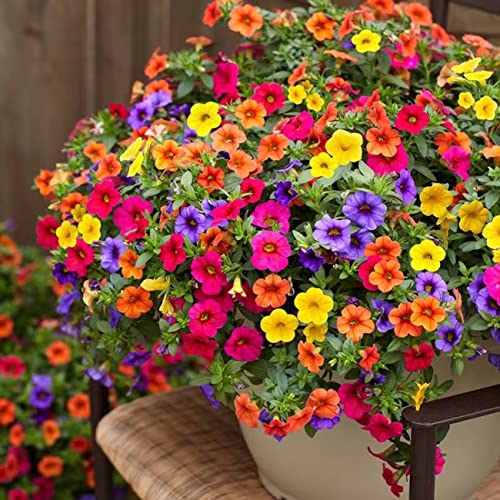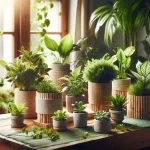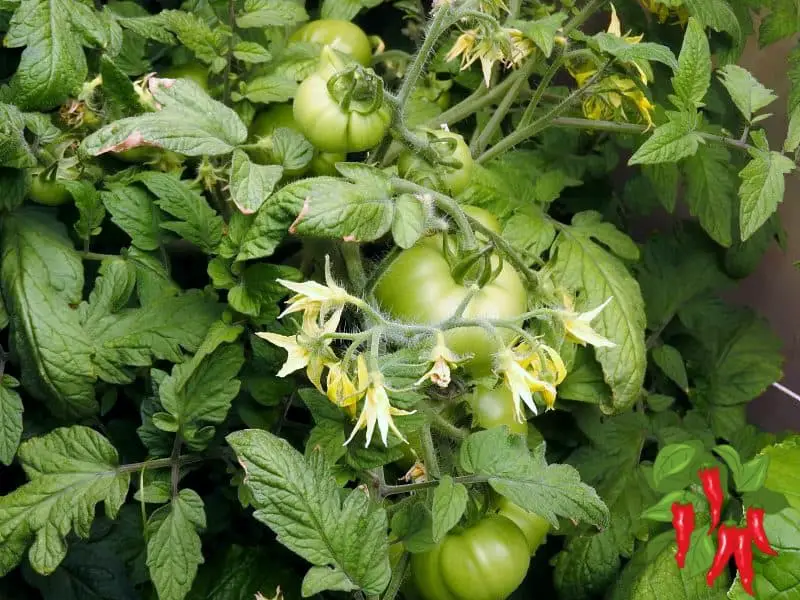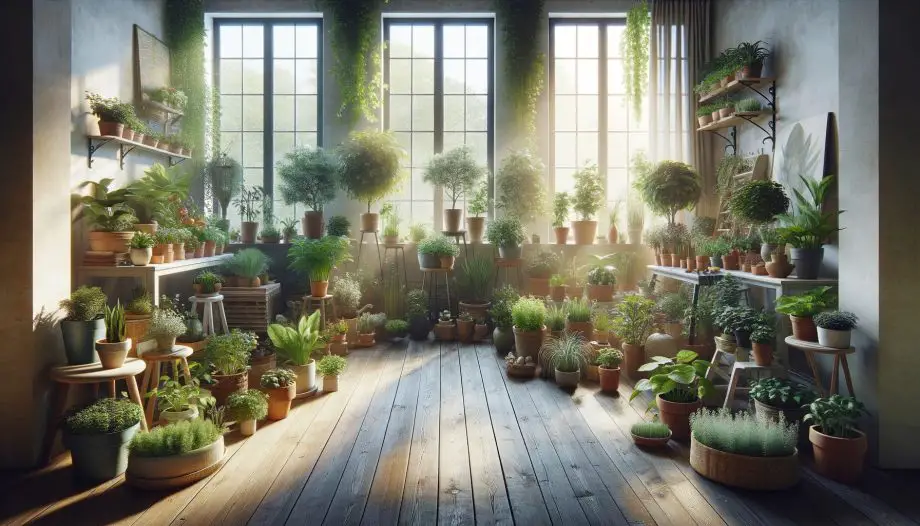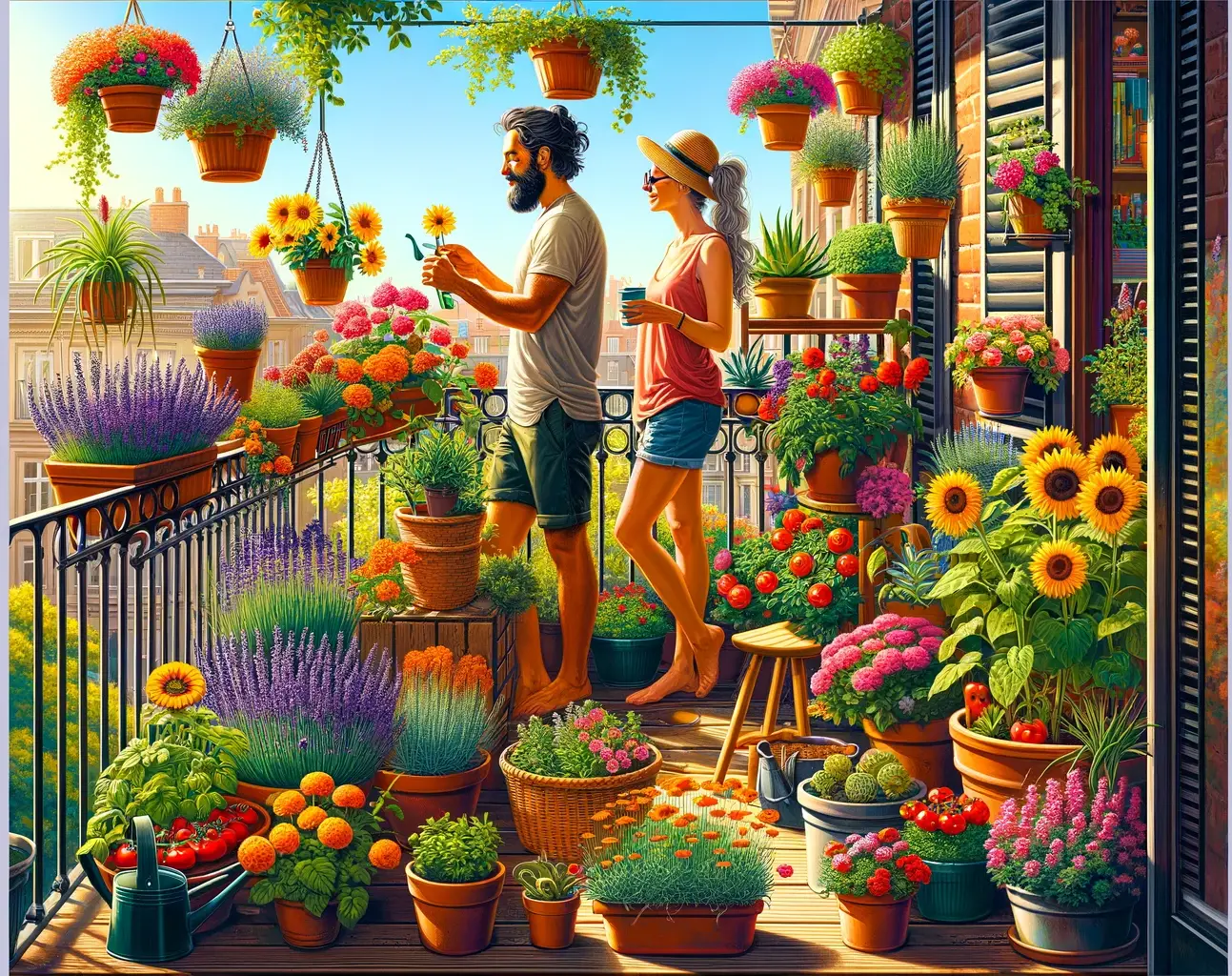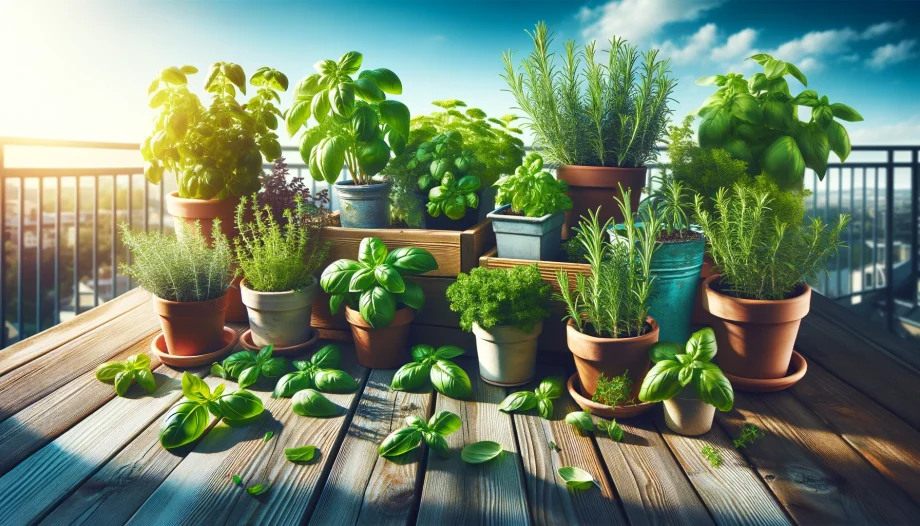
Embark on a green journey right in your urban home with indoor apartment gardening. Discover the joy of growing your own herbs, veggies, and blooms!
Indoor Apartment Gardening
Imagine turning your living space into a green oasis with indoor apartment gardening.
It’s not just about the lush, vibrant ambiance, but also the joy of plucking fresh herbs for your meal, or waking up to the sight of blooming flowers.
Indoor apartment gardening is an enriching journey, a hobby that cultivates patience, care, and a deeper appreciation for nature’s bountiful beauty.
Whether you possess a sprawling balcony or merely a sunny windowsill, every nook holds the promise of a budding garden.
So, let’s delve into the verdant world of indoor apartment gardening and unfold the green thumb that lies within you.
Apartment Gardening Key Takeaways:
- Indoor apartment gardening is the cultivation of plants within your apartment.
- It utilizes spaces like windowsills, balconies, or countertops.
- It allows for growing herbs, vegetables, fruits, and ornamental plants.
- It offers a green respite in urban settings, enhancing air quality, and providing fresh produce right at home.
Can I Make a Garden in My Apartment?
Yes, you can! Embarking on the green path of indoor apartment gardening is not just a creative endeavor, but a statement of self-sufficiency and love for nature.
Whether you have a sprawling balcony or just a sunny windowsill, every apartment holds the promise of a thriving garden.
There are many ways to garden in restricted spaces. Often a small or limited space is an issue in growing and cultivating plants. Restricted space gardens can be located on small lawns, balconies, patios, porches, rooftops, inside the home, or in any other available place. Gardening in small places can be applied to edible or floral plants. Growing food has many benefits including saving money; healthier, fresher, and better tasting food; knowledge of pesticide and fertilizer exposure. Gardening is a good form of exercise and has been proven to be therapeutic.
This comprehensive guide to apartment gardening takes you through starting your own indoor oasis, providing tips on how to make the most of your space, and introducing you to a variety of plants suited for apartment gardening.
Getting Started

Embarking on the delightful journey of indoor apartment gardening begins with a thorough understanding of your living space and its potential to support plant life.
This initial phase lays the foundation for a flourishing garden that resonates with your lifestyle and the spatial attributes of your apartment.
Here, in this guide to apartment gardening, we’ll dive into the essential steps to kickstart your gardening endeavor.
Along the way, we will provide you with helpful apartment gardening tips and help choosing the best plants from raising vegetables, to flowers and succulents and apartment gardening with foliage plants.
Assessing Your Space:
1. Light Assessment: – Sunlight is the lifeblood of plants. Identify areas in your apartment that receive ample sunlight, typically near south-facing windows or balconies.
Understand the sun’s trajectory throughout the day to find spots that bask in the morning sun or the afternoon glow, catering to the light requirements of different plants.
2. Space Measurement: – Measure the available space on windowsills, balconies, countertops, or any other area suitable for gardening.
Assess the dimensions to choose containers and planters that fit well while leaving enough room for your plants to grow and for you to move around comfortably.
3. Ventilation Check: – Good airflow is essential for plant health as it helps in preventing mold and diseases.
Ensure that your chosen gardening spots have adequate ventilation, especially if you are planning a balcony garden.
Planning Your Garden:
1. Setting Goals: – Are you looking to grow your own food, foster a floral paradise, or both?
Setting clear goals will guide your plant selection and garden design, aligning them with your personal aspirations and the aesthetics of your apartment.
2. Style Selection: – Choose a gardening style that resonates with your space and personal taste.
Whether it’s the rustic charm of container gardening, the modern appeal of vertical gardening, or the innovative edge of hydroponic systems, selecting a style lays the groundwork for your garden setup.
3. Budgeting: – Gardening can be as economical or as lavish as you make it.
Allocate a budget for essential items like containers, soil, plants, and gardening tools.
Look for ways to economize, like repurposing containers or swapping plants and seeds with fellow gardening enthusiasts.
Equipment and Supplies:
1. Containers and Planters: – Acquire containers and planters that complement your garden style.
Ensure they have adequate drainage to prevent waterlogging.
2. Soil and Compost: – Purchase good quality soil and compost that provide the right nutrient mix for your plants to thrive.
Coco coir is an excellent environmentally sustainable choice. Learn how to use coco coir bricks.
3. Gardening Tools: – Basic tools like a trowel, pruning shears, and a watering can are essential for planting and maintaining your garden.
The Getting Started phase is a blend of enthusiasm, planning, and understanding the dynamics of your living space.
It’s about envisioning the potential of your apartment to morph into a verdant haven, nurturing a harmonious relationship between your living space and the plants.
As you measure, plan, and prepare, you’re one step closer to seeing the first sprouts of green in your cozy apartment garden.
Garden Setup Ideas
Creating a flourishing garden within the bounds of an apartment calls for a mingling of creativity and practicality.
From selecting the right containers to optimizing your balcony space, each setup idea brings a unique flavor to your indoor gardening venture.
Here’s a rundown of various garden setup ideas to ignite your green imagination.
Container Gardening:
Container Types: Dive into a world of containers each with its unique aesthetic and functional appeal.
Traditional pots, modern vertical planters, and whimsical hanging baskets offer a plethora of choices to suit your style and space.
Read more: Best Trailing Plants for Hanging Baskets
Placement: Placing containers strategically ensures your plants receive adequate sunlight and air.
Windowsills, balconies, and well-lit corners are ideal spots. Ensure your containers have proper drainage holes to keep plants healthy.
Learn how to grow lavender in pots.
Balcony Gardening:

Designing: Designing a balcony garden is akin to painting a living canvas.
Plan a layout that accommodates a variety of plants while allowing easy movement for care and enjoyment.
Consider incorporating a mix of containers, vertical planters, and perhaps a raised bed to maximize space.
Safety Measures: Safety is paramount. Ensure heavy containers are securely placed to prevent tipping.
Create a child and pet-friendly garden by choosing safe, non-toxic plants and securing any hazardous gardening tools.
Hydroponic Systems:
Introduction to Hydroponics: Hydroponics, the art of soilless gardening, is a modern approach that allows for precise control over the growing environment.
Understanding the basic setup, including nutrient solutions and growing mediums, is the stepping stone to a successful hydroponic garden.
Maintenance: Maintaining a hydroponic system requires a regular check on nutrient solutions, pH levels, and light requirements.
Familiarize yourself with the maintenance regime to ensure a thriving garden.
Countertop Gardening:

Utilizing Grow Lights: Grow lights are a boon for indoor gardens, supplementing sunlight and ensuring your plants receive the necessary light spectrum for growth.
Plant Choices: Herbs, microgreens, and compact vegetable varieties are perfect candidates for countertop gardening.
Short on space? Learn how to grow microgreens.
They require minimal space and offer fresh produce for your culinary adventures.
Find out the difference between microgreens and sprouts.

The AeroGarden is great for countertop gardening. It is compact, has its own light, and is an easy-to-use hydroponic growing system. I have one myself and love it.
Read my honest AeroGarden Review.
Vertical Gardening:

Creating a Vertical Setup: Vertical gardening is about growing skywards. Utilize wall space by installing vertical planters, shelves, or creating a green wall.
Plant Selection: Opt for a mix of foliage and flowering plants with varying textures and colors to create a visually appealing vertical garden. Ensure the plants chosen are suited for the light conditions of the space.
Each of these garden setup ideas can be tailored to the unique attributes of your apartment, paving the way for a verdant retreat amidst the urban jungle.
Whether you choose one or a blend of these ideas, your indoor garden will surely be a sanctuary of greenery, blossoms, and bountiful harvests.
III. Plant Selection
The essence of your garden is undeniably the selection of plants. A well-thought-out selection not only enhances the aesthetic appeal of your space but also caters to your personal preferences and the level of care you can provide.
Whether you’re keen on growing your own food, creating a floral haven, or both, picking the right plants is crucial.
Here’s a detailed breakdown to guide you through selecting plants for your indoor apartment garden.
Herbs:
Herbs are a splendid choice for indoor apartment gardening. They are generally easy to care for, require modest space, and come with the added bonus of elevating your culinary endeavors.
Basil: A versatile herb, basil thrives in well-draining soil and plenty of sunlight. Its aromatic leaves are a great addition to salads, pasta, and pizzas.
Mint: Mint is a hardy herb that grows well in pots. It prefers a slightly shaded spot and moist soil. Mint leaves are perfect for teas, desserts, and garnishing.
Rosemary: Rosemary is a perennial herb that loves the sun. It’s not only a flavorful addition to various dishes but also a beautiful, fragrant plant to have in your garden.
Vegetables:
Growing your own apartment vegetable garden is a rewarding experience. Select compact varieties that are suited for container gardening.
Tomatoes: Choose dwarf or patio varieties of tomatoes. They require a sunny spot and well-draining soil.
Peppers: Small pepper plants can thrive in containers on a sunny windowsill or balcony. They add a pop of color and are a spicy addition to meals.
Salad Greens: Salad greens like lettuce and spinach are easy to grow and can be harvested over a period of time.
Learn how to grow lettuce in an AeroGarden
Fruits:
Growing fruits in your apartment may require a bit more care but the sweet harvest is well worth the effort.
Strawberries: Strawberries can be grown in hanging baskets or containers. They need plenty of sunlight to produce sweet berries.
Dwarf Citrus Trees: Consider growing dwarf varieties of citrus trees like lemons or oranges. They need a sunny spot and well-draining soil.
Flowers:
Flowers bring a burst of color and a touch of nature to your indoor space. They are also beneficial for pollinators if you have a balcony garden.
Petunias: Petunias are colorful and hearty flowers that can thrive in containers. They prefer a sunny location and bring a vibrant touch to your garden.
Marigolds: Marigolds are not only beautiful but also act as natural pest deterrents, a win-win for any garden.
Begonias: Begonias are a shade-loving flower that comes in a variety of colors, perfect for adding a soft touch of beauty to your garden.
Choosing a mix of herbs, vegetables, fruits, and flowers creates a diversified garden.
It caters to your aesthetic preferences, culinary interests, and the joy of nurturing life from the seed to bloom and fruit.
Each plant you choose brings you one step closer to creating a personal oasis amidst the bustling urban life.
IV. Care and Maintenance
The journey of indoor apartment gardening extends beyond the initial setup, venturing into a phase of nurturing and tending.
A thriving garden is a testament to consistent care and a keen understanding of the needs of your plants.
This section delves into the critical aspects of care and maintenance that ensure your garden remains a healthy, vibrant sanctuary.
Watering:
Watering is a fundamental aspect of gardening, yet it’s a delicate balance. Too little or too much water can lead to the demise of your plants.
Watering Needs: Each plant has its unique watering needs. While succulents and cacti thrive on neglect, herbs and vegetables require regular watering.
Understanding the water requirements of each plant in your garden is crucial.
Drainage: Ensuring proper drainage is equally important to prevent waterlogging, which can lead to root rot.
Ensure your containers have drainage holes, and consider placing a tray beneath to catch excess water.
Watering Techniques: Explore different watering techniques like bottom watering, which encourages roots to grow downward and is especially beneficial for deep-rooted plants.
Soil and Fertilizer:
The foundation of a flourishing garden lies in the quality of soil and the nourishment provided through fertilizers.
Soil Mix: – Selecting the right soil mix that provides good drainage and retains moisture is key.
A well-aerated, nutrient-rich soil provides a conducive environment for root growth.
Fertilization: – Plants derive essential nutrients from the soil, but over time these nutrients deplete.
Learn about the fertilization needs of your plants and consider organic fertilizers like compost or vermicompost to replenish nutrients.
Pest and Disease Management:
A proactive approach towards pest and disease management is essential to maintain a healthy garden.
Organic Pest Control: Explore organic methods to control pests. Neem oil, diatomaceous earth, and insecticidal soap are effective natural deterrents against a range of common garden pests.
Disease Prevention: Preventing diseases begins with good gardening practices like proper watering, adequate spacing between plants, and regular cleaning of fallen leaves and debris.
Regular Inspection: Inspect your plants regularly for signs of pests or diseases. Early detection and intervention can prevent minor issues from escalating into major problems.
The journey of care and maintenance is ongoing, cultivating a rhythm between you and your garden.
It’s about responding to the needs of your plants, understanding the signs they exhibit, and providing a nurturing environment for them to grow and flourish.
Through diligent care, you’ll witness the rewarding sight of blooming flowers, lush foliage, and bountiful harvests, making the effort well worth it.
V. Troubleshooting and Common Challenges
Every green haven, irrespective of its size and location, encounters hurdles along the way.
Being prepared to troubleshoot common issues is the key to maintaining a thriving garden.
Here’s a deeper dive into some common challenges and how to navigate through them:
Inadequate Light:
1. Recognizing the Problem: Plants leaning towards light, pale leaves, elongated stems, or lack of blooming are signs of light deprivation.
Understanding these signs is the first step in addressing the issue.
2. Employing Grow Lights: Grow lights are a boon for indoor gardeners facing light inadequacy.
They come in various types of fluorescent, and LED grow lights, each catering to different plant needs.
Understand the light requirements of your plants and choose grow lights that emulate the sun’s spectrum, ensuring your plants receive the light they crave.
3. Adjusting Plant Location: Sometimes, relocating your plants to a brighter spot, closer to natural light sources like windows or balconies, can resolve the issue.
Rotation of plants to ensure they receive light uniformly can also be beneficial.
Pests and Diseases:
1. Identifying Common Pests: Pests like aphids, spider mites, and whiteflies are common adversaries.
Learn how to get rid of spider mites
Regular inspection, especially underneath leaves and around stems, helps in early detection and control.
2. Understanding Common Diseases: Fungal diseases like powdery mildew and root rot are common in indoor settings, often exacerbated by over-watering and poor ventilation.
Recognizing the early signs of diseases helps in prompt intervention.
3. Organic Control Measures: Embracing organic pest and disease control measures is a safe and eco-friendly approach.
Neem oil, insecticidal soap, and diatomaceous earth are effective against a variety of pests.
For fungal diseases, ensuring good airflow and using anti-fungal organic sprays can be beneficial.
4. Maintaining a Healthy Environment: A clean, well-ventilated garden with proper watering practices is less likely to face severe pest and disease issues.
Regular cleaning of fallen leaves and debris, coupled with adequate spacing between plants, discourages the onset of pests and diseases.
Facing challenges head-on, armed with knowledge and effective solutions, ensures your garden continues to flourish.
Each challenge surmounted enriches your gardening experience, leading to a more robust and resilient green sanctuary in your apartment.
VI. Benefits of Indoor Apartment Gardening

Nurturing a garden within the confines of your apartment is not merely about growing plants; it’s about cultivating a healthier and more harmonious living space.
The myriad benefits of indoor apartment gardening stretch beyond the aesthetic appeal, weaving into the fabric of your well-being and the environment around you.
Air Quality:
Plants act as natural air purifiers, absorbing toxins and emitting oxygen.
They help in filtering out harmful pollutants, contributing to a cleaner, fresher indoor atmosphere.
The green foliage also maintains humidity by releasing water vapor during transpiration, creating a balanced indoor environment.
Mental Health:
The act of gardening is a journey into a stress-free zone.
It’s a therapeutic activity that calms the mind, offering a respite from the hectic pace of modern life.
The sight of greenery, the act of nurturing life, and the gentle rhythm of gardening tasks create a meditative space, promoting mental well-being.
The ripple effects of indoor apartment gardening are profound, creating a ripple of positive impacts.
It’s an endeavor that enhances your living space, and your mental health and contributes to a healthier environment, making it a rewarding and enriching venture.
VII. Urban Apartment Gardening
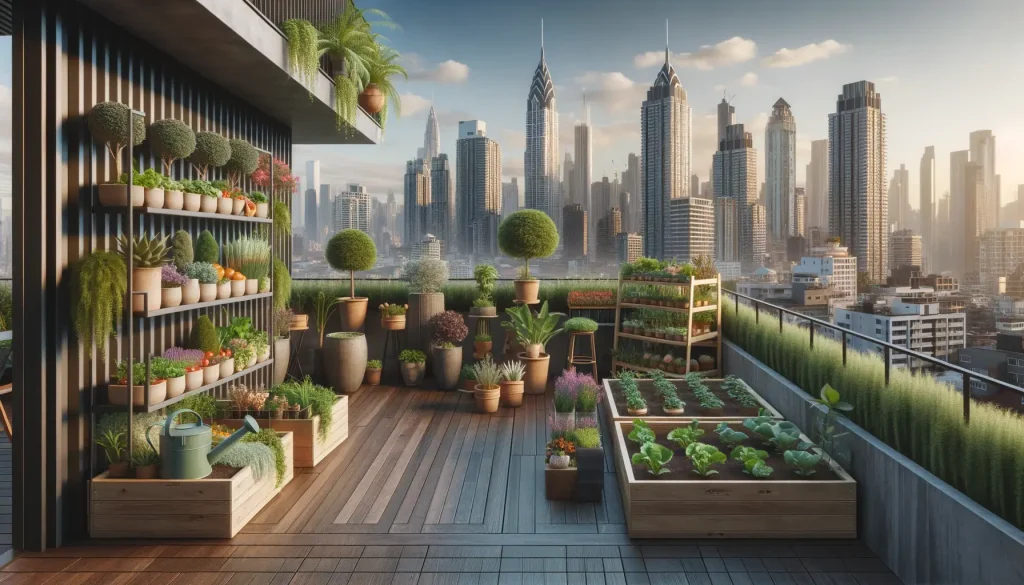
The concrete jungle often yearns for a touch of green, and urban apartment gardening is a rising trend that allows city dwellers to fill this void, weaving a patch of nature into the urban fabric.
This practice not only enhances the aesthetics of city apartments but also promotes a sustainable lifestyle. Here’s how:
Reconnection with Nature:
1. Mental Oasis: Amidst the hustle and bustle of city life, an apartment garden serves as a tranquil oasis, offering a mental retreat.
It’s a space where one can reconnect with nature, enjoy the serenity, and find a moment of reprieve.
2. Educational Experience: Gardening is an educational journey where individuals learn about different plant species, their growth cycles, and the basics of horticulture.
It’s a hands-on way to understand nature’s workings.
Promoting Sustainability:
1. Reduced Carbon Footprint: Growing your own food reduces the demand for commercially grown produce, which often comes with a hefty carbon footprint due to transportation and packaging.
2. Composting: Urban gardeners can practice composting by recycling kitchen waste into nutrient-rich compost for the garden, reducing the amount of waste that ends up in landfills.
Enhanced Food Security:
1. Fresh Produce: Having a garden allows for a supply of fresh, organic produce right at your doorstep.
It’s a step towards self-sufficiency and enhanced food security.
2. Healthier Eating: When you grow your own vegetables and herbs, you are more likely to have a diet rich in fresh, nutritious produce.
Community Engagement:
1. Shared Gardening Spaces: Urban apartment gardening can foster community engagement.
Shared gardening spaces or community gardens promote social interaction, shared learning, and a sense of community among urban dwellers.
2. Educational Workshops: Hosting or participating in gardening workshops within the community can be a platform for learning, sharing experiences, and promoting the benefits of urban gardening.
Urban apartment gardening is more than a hobby; it’s a lifestyle choice promoting sustainability, self-sufficiency, and community engagement.
It allows individuals to create a slice of paradise amidst the urban chaos, nurturing a harmonious relationship between urban living and nature’s essence.
VII. Gardening in an Apartment without a Balcony

The absence of a balcony in an apartment might seem like a roadblock to gardening ambitions, but it’s far from a dead end.
You can garden in an apartment without a balcony. Believe me, because I do it every day!
Numerous indoor gardening solutions enable you to indulge your green thumb and cultivate a garden that thrives indoors. Here’s how you can navigate through the lack of outdoor space:
Window Gardening:
1. Utilizing Windowsills: Windowsills are often underutilized spaces that can be transformed into thriving gardening spots. They provide natural light, which is crucial for plant growth.
2. Hanging Planters: Hanging planters on or near windows can also maximize the use of vertical space while ensuring your plants receive adequate sunlight.
Container Gardening:
1. Variety of Containers: A plethora of container types like pots, vertical planters, and hanging baskets provide versatility and enable you to place plants in various indoor spots.
2. Mobile Planters: Mobile planters on wheels allow for easy movement, enabling you to shift your plants around based on light requirements or aesthetic preferences.
Indoor Vertical Gardening:

1. Wall-mounted Planters: Utilize wall space by installing wall-mounted planters or creating a living wall. It’s an aesthetic and space-saving solution
2. Tiered Shelves: Employing tiered shelves for housing multiple plants is a smart way to make the most of limited floor space while creating a green nook.
Hydroponic Systems:
1. Soilless Gardening: Hydroponic systems, which require no soil, are an excellent solution for indoor gardening. They allow for precise control over nutrients and watering, often leading to faster plant growth.
2. Compact Hydroponic Kits: Compact hydroponic kits are available which are suitable for small indoor spaces. They are a neat, tidy solution for growing plants indoors with minimal mess.
Grow Lights:
1. Supplementing Natural Light: Grow lights are a game-changer for indoor gardening, especially in apartments lacking ample natural light.
They provide the necessary spectrum of light for photosynthesis, ensuring your plants thrive.
2. Adjustable Grow Lights: Adjustable grow lights allow you to control the light intensity and duration, catering to different plant needs and promoting healthy growth.
The lack of a balcony only nudges you to explore the myriad indoor gardening avenues.
Each of these solutions provides a pathway to nurture your gardening hobby, bringing a slice of nature into your indoor living space.
The joy of seeing your indoor garden flourish is boundless, making the venture well worth the effort.
VIII. Best Vegetables to Grow in an Apartment
Venturing into the realm of homegrown vegetables is an enticing endeavor.
It paves the way for fresh, organic produce right from your living space.
Apartment gardening may come with space constraints, but a variety of compact vegetables are well-suited for this setting.
Here’s a dive into some of the best vegetables to cultivate in your apartment garden:
Leafy Greens:
1. Lettuce: Lettuce is a low-maintenance vegetable that thrives in small containers.
It prefers cooler temperatures, making it an ideal vegetable for indoor gardening.
2. Spinach: Spinach is a nutrient powerhouse that grows well in shaded areas, making it suitable for apartments with less sunlight.
Root Vegetables:
1. Radishes: Radishes are compact root vegetables that grow quickly and require minimal space. They can be harvested in about 25-30 days from planting.
2. Carrots: Short varieties of carrots like ‘Little Finger’ or ‘Parisienne’ are well-suited for container gardening. Ensure deep enough containers for their growth.
Herbaceous Vegetables:
1. Tomatoes: Compact varieties like cherry or grape tomatoes are perfect for apartment gardening. They can be grown in hanging baskets or containers near a sunny window.
2. Peppers: Small pepper plants like chili or bell peppers can thrive in pots. They are sun-loving vegetables that add a splash of color to your indoor garden.
Read about Growing Hydroponic Peppers and Tomatoes
Podded Vegetables:
1. Peas: Dwarf pea varieties are suitable for indoor gardening. They require a small trellis for support and prefer cooler temperatures.
2. Green Beans: Bush varieties of green beans are compact and do well in containers. They are fast growers and provide a steady supply of fresh beans.
Cucurbits:
1. Cucumbers: Compact cucumber varieties like ‘Bush Pickle’ or ‘Spacemaster’ are suitable for apartment gardening. They can be grown in large containers with some support for climbing.
2. Zucchini: Dwarf zucchini varieties can be grown in containers. They require a sunny spot and ample space for their broad leaves.
Each of these vegetables brings the joy of homegrown produce to your apartment, enhancing your gardening experience.
With a bit of care, attention, and the right choice of vegetable varieties, your apartment garden can transform into a mini vegetable farm, contributing to a healthy, sustainable lifestyle.
IX. FAQs
The path to cultivating a garden within your apartment may spark numerous questions. Here we address some common queries in a Q and A format:
Q: Can I grow a garden in my apartment?
A: Absolutely! With a dash of creativity, the right approach, and a smidge of care, you can cultivate a thriving garden in your apartment.
Whether it’s a small herb garden on your windowsill or a mini vegetable farm on your balcony, the possibilities are endless.
Q: What is the best plant to grow in an apartment?
A: The best plant for your apartment garden hinges on your space, light availability, and personal preferences.
Herbs like basil and mint, succulents, and indoor-friendly vegetables like cherry tomatoes and salad greens are great choices for starters.
Q: How often should I water my indoor plants?
A: The watering schedule varies from plant to plant. It’s essential to understand the water requirements of your specific plants.
A general rule is to water when the top inch of soil feels dry to the touch.
Q: How can I maximize space for gardening in a small apartment?
A: Utilizing vertical space, employing hanging planters, and opting for multi-tiered shelves are smart ways to maximize gardening space in a small apartment.
Q: Is there a way to garden without soil in an apartment?
A: Yes! Hydroponic systems allow for soilless gardening, where plants are grown in nutrient-rich water solutions.
This method is a fantastic space-saver and often results in faster plant growth.
Your indoor gardening adventure is a learning experience, and as you delve deeper, you’ll find answers to more queries, refining your gardening skills with each passing season.
X. Conclusion

Embarking on an indoor apartment gardening journey is indeed a fulfilling venture.
It’s a blend of patience, creativity, and the simple joy of watching life bloom within the confines of your home.
Watch my YouTube channel Small Farms Big Ideas for more growing tips. Find out more in my Welcome To Small Farms Big Ideas.
With proper planning, a bit of research, and tender care, you can transform your apartment into a verdant retreat, a personal haven amidst the urban chaos.
Read more about Fittonia Indoor Care
Reaping Rewards:
1. Fresh Produce: The joy of plucking fresh herbs, vegetables, or even fruits from your own garden is incomparable.
It not only enhances the taste of your home-cooked meals but also uplifts your spirit.
2. Therapeutic Engagement: The act of gardening, nurturing each plant, and watching them grow is therapeutic.
It’s a peaceful engagement that calms the mind and rejuvenates the soul.
A Serene Environment:
1. Visual Appeal: The visual appeal of a well-maintained garden is undeniable.
The lush greenery, accompanied by colorful blooms, adds a refreshing touch to your living space.
2. Enhanced Air Quality: The plants contribute to cleaner air by filtering out pollutants, creating a fresh, healthy living environment.
Educational Journey:
1. Learning Curve: Gardening is an educational journey, teaching patience, the significance of consistency, and the basics of plant care.
It’s a hands-on way to learn about nature, growth cycles, and the beauty of life.
2. Community Interaction: It also opens doors for community interaction, sharing gardening tips, and experiences with fellow gardening enthusiasts, enriching your gardening journey.
Towards a Sustainable Lifestyle:
1. Eco-Friendly Practice: Apartment gardening steers you towards a more sustainable lifestyle. It’s a small yet significant step towards eco-friendly living, promoting recycling, organic gardening, and self-sufficiency.
Fostering Responsibility:
1. Care and Maintenance: The responsibility of caring for your plants, ensuring they are watered, fed, and protected from pests and diseases, fosters a sense of responsibility, enriching not just your living space but your character too.
Setting forth on this green path might come with its share of challenges, but the rewards are well worth the effort.
Your apartment garden awaits, ready to flourish under your care, transforming your living space into a serene, beautiful, and rewarding environment.
Learn the secrets to Nerve Plant Care






